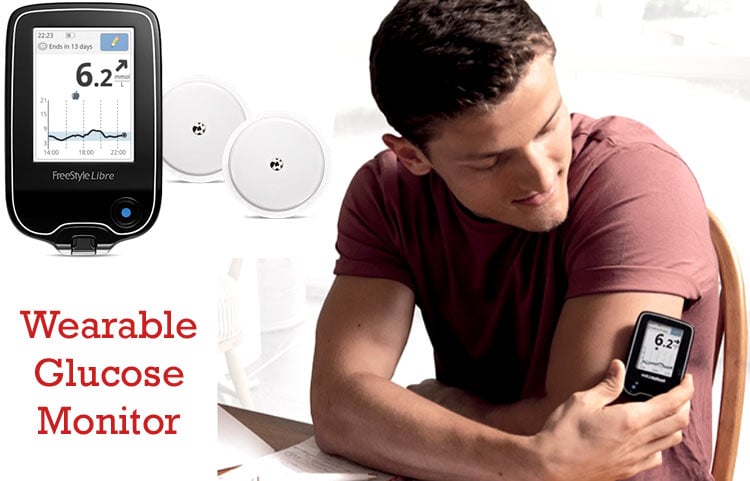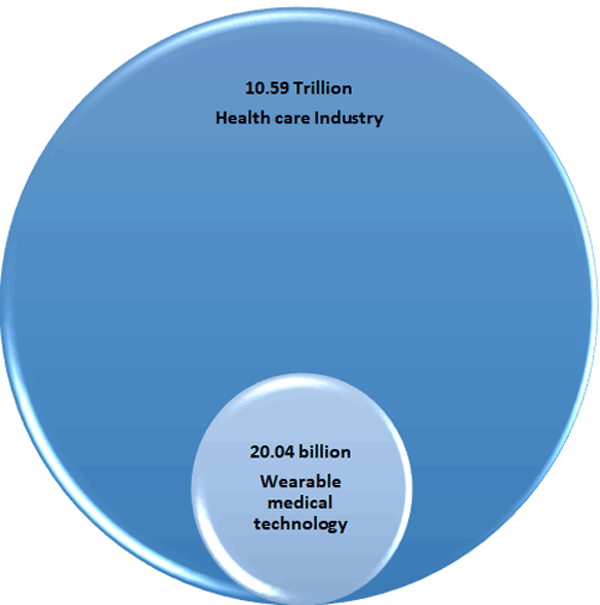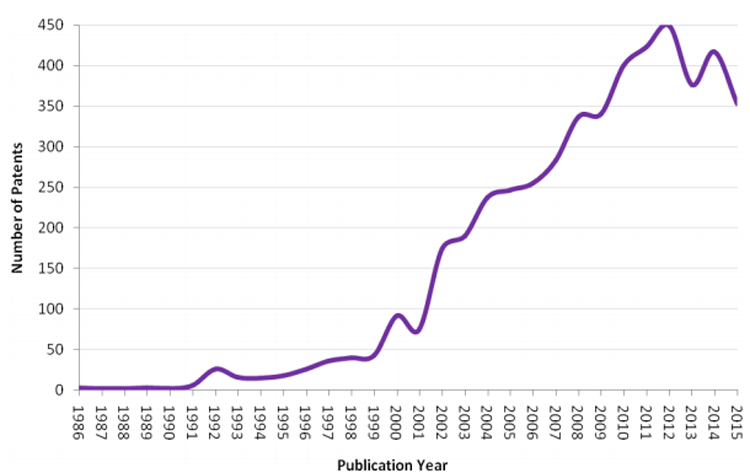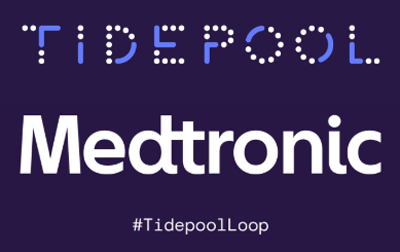
Human lifespan has exponentially increased in recent times and is expected to go up to 80 years till 2050. One of the most important factors based on which the age graph has increased is the involvement of Information and communications technology (ICT) in the health care sector is continuously increasing, giving rise to a major innovation in various medical devices and techniques. Companies and various startups are building around the industry focusing on improvements in techniques in the current landscape of health industry while the others are building around remote patient monitoring devices and other wearable electronics which are helping to decrease the involvement of doctors and hospitals and thus challenging the orthodox techniques of this industry.
Medical Wearable Industry
Factors like aging, growing population, prevalence of chronic disease lead to exponential advances in innovative but costly digital health care technology. The health care industry is expected to set a new high of USD $ 10.059 trillion in term of 2017-2022. The medical wearable industry is witnessing a growth at CAGR of 26.1 % over the forecast period of 2018-2022 and was valued at 10.3 billion in 2018, which forecasts a value of 20.04 billion in 2022.

Self-diagnostic medical devices (SDMD’s) which are the part of the wearable medical devices is also witnessing a positive momentum in patent filing trend and is rising since this decade. The Patent publication trend graph for SDMD devices over the recent years is shown below.

Diabetes – An Epidemic disease
Diabetes which is scientifically known as Diabetes mellitus is a worldwide epidemic disease. The disease is related to a disorder in which the blood glucose level either increases or decreases than the standard prescribed value. Diabetes is divided into two types according to the level of insulin production. If body produces insufficient level of insulin then its Type 1 Diabetes or the produced insulin can’t be utilized i.e. insulin is produced in excess then it is known as Type 2 Diabetes. Diabetes is a worldwide epidemic; millions of people are suffering from it but the count of people suffering from type 2 diabetes is exceptionally high. Both type 1 and type 2 diabetes are affecting the people around the globe but the rise has been greater for type 2 which values for 90–95% of all the cases of diabetes this number is continuously rising leading to a severe burden on the national health care system especially for the developing countries. Stats value around 4.8 million Koreans (13.7% of the Korean population) of 30 years or older have diabetes, while in the US the number goes up to 30.3 million people of all ages. in India more than 62 million people are suffering from diabetes. A total worldwide estimate of people with diabetes is projected for 366 million in 2030.
A new state of Diabetes Monitoring using Wearable Devices
Since ages, traditional methods are used for glucose monitoring which involves pricking of a finger by needle and testing the blood in a meter for the sugar levels. However, new type of Wearable Tech Gadget, a state of the art wearable glucometer system is being developed which will eliminate the pain of the needle. Primarily these methods involve the use of sensors for sensing the glucose level in the blood through body fluid such as sweat. Many companies are building these devices and are integrating them into small packages so that they don’t create any hindrance in our daily routines.
Companies leading with Wearable Diabetes Monitoring Devices
Apple known for innovation with elegant designs is planning to expand its portfolio in health-care market with the launch of the next Apple Watch model. Apple and Dexcom are in strategical partnership for rolling out wearable glucose monitor feature in their smart watch for blood sugar measurement. Dexcom is known for manufacturing compact glucose monitoring devices, this strategic launch would definitely attract more buyers increasing the company’s revenue and would definitely be a monopoly for the premium health care device market. Launch of this feature would not only help to monitor blood glucose level but also detect the conditions ahead of time.

Tidepool, a nonprofit organization which is committed to provide free software for the diabetes community to work with diabetes devices had recently announced its partnership with Medtronic for an automated insulin pump which leads to a mini bluetooth enabled pump system working with Tidepool Loop, an open-source iPhone and Apple Watch app.

Abbott Diabetes Care recently received a CE Mark for the FreeStyle Libre System which is a glucose monitoring system for people who are suffering from diabetes. The Company is also looking to venture into the smart wearables in the healthcare industry. The system includes a sensor that is placed on the upper arm for 14 days to read glucose information. The sensor is connected to the application for reading the glucose levels, at whole the system eliminates the need for the finger prick system for glucose testing. The app also gives suggestions about the food a person should eat to help for controlling diabetes through exercise and proper diet.

Major medical device manufacturers and startups working in health care field are looking further to develop advanced wearables that can monitor blood glucose to deliver appropriate insulin dose. In the coming time, we hope to see the evolution of the internet of healthcare things (IoHT) and medical wearables that provide more control on health than ever before.
Besides these wearable glucose monitors, this sector is continuously growing leading to new applications which are used with the help of socks, shoes, and even contact lenses. The medical authorities such as FDA is approving a new wave of devices that promise to streamline diabetes management. These tools are smart that they can maintain a patient profile along with vital signs and health analytics, and determine risk levels. The shoes and socks developed by scientists for people with diabetes. These wearables are Pre-installed with pressure and heat sensors to detect areas of the foot with inadequate blood supply, reducing the development of foot ulcers and lower the risk of amputations.
Google and Novartis are working to make contact lens embedded with a small chip which could monitor blood glucose level through eye fluids such as tears. Implantable devices are also leading the race; bio-artificial pancreas is a small capsule that works like natural pancreas. This capsule is loaded with the stem-cell so as to produce insulin. scientists are also working on several other implants that could help to automatically deliver drugs and insulin based on blood glucose levels.
Integrated and Closed Loop Apps and Devices
Dexcom Continuous glucose monitoring (CGM) system approved by FDA is a kind of device that can be used as integrated with other devices and interfaces. The compatible device list includes automated dosing systems, insulin pumps, glucose meters and other devices used for diabetic management. This continuous sugar monitoring wearable device can not only measure the level glucose in your blood, but can also administer you with the required dosage of insulin.
Guardian Connect System developed by Medtronic measures glucose levels every 5 minutes and displays the values through their Guardian Connect app installed on a compatible mobile device. users are able to detect trends and track patterns in glucose concentrations to help keep blood glucose levels in a safe range.
Eversense Continuous Glucose Monitoring System developed by Senseonics. consists of a fluorescence-based sensor, a transmitter, and a mobile app which provides real-time glucose monitoring in every five minutes for up to 90 days. It displays trends, alerts related to glucose values on the mobile device.
Continuous Glucose Monitors (CGM) Device Market
India is one of the top three healthcare markets in the world in terms of incremental growth, it contributes to the 2.5 percent of GDP in the 12th Five Year Plan. Having a doctor-to-patient ratio as per the Medical Council of India is at 1:1,674, which is below the WHO’s recommendation of 1:1,000. The need for adopting smart wearables is a must which allows people to responsibly self-check their health indicators. The Healthcare Industry is one of India’s largest sectors - both in terms of revenue and size.
Continuous glucose monitoring (CGM) devices and insulin pumps measure glucose levels from fluid under the skin without pricking it. The readings from CGMs helps to advise the doctors/ patient’s what course of action to be taken, or in the case of emergencies, information can be sent immediately to healthcare providers. Currently, the market of CGM devices prevails primarily in the North American and Europe. The device market would be expanding in emerging markets such as Asia, Africa, and the Middle East. The current demand from the companies is to create more efficient treatment devices, in terms of both ease of use and cost, that would help diabetics to properly manage their condition.
The current value of the global digital diabetes management market is USD 6.8 billion and is expected to reach USD 19.9 billion in 2024 with a CAGR of 23.8%. The main reason for the growth of this market is due to a rise in the prevalence of diabetes. Companies are increasing their focus on the development and adoption of digital platforms for diabetes. The digital diabetic devices and software’s includes a diverse range of Devices like Smart Glucometer, Continuous glucose monitoring devices(CGM), Insulin Pumps, Patches, Diabetes Apps, Services, Data Management Software’s, Hand-held & Wearable devices and pumps.
Some of the Global major player’s in digital diabetes management market are Medtronic (Ireland), B. Braun (Germany), Dexcom (US), Abbott Laboratories (US), Roche Diagnostics (Switzerland), Insulet Corporation (US), Tandem Diabetes Care (US), Ascensia Diabetes Care (Switzerland), LifeScan (US), Tidepool (US), AgaMatrix (US), Glooko Inc. (US), and DarioHealth (Israel).
The market for continuous glucose monitors and digital diabetic control devices is getting crowded as technology is advancing. Additionally, research is being carried out to lower the risks of proven diabetic diseases such as blindness, kidney failure, heart attacks, strokes and lower limb amputation. This would help in bringing down the incidence as well as mortality associated with diabetes.





